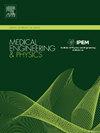用于CMAP扫描研究的自动步进分析算法
IF 2.3
4区 医学
Q3 ENGINEERING, BIOMEDICAL
引用次数: 0
摘要
目的建立肌萎缩性侧索硬化症(ALS)患者复合肌肉动作电位(CMAP)扫描曲线步长分析的自动化方法,并比较常规半自动化和新型自动化方法计算的步长参数与对照组的差异。方法选取20例ALS患者和15例对照患者。刺激腕部正中神经,记录外展短肌CMAP扫描。自动步骤分析软件通过使用指示步骤的新参数显示CMAP扫描图形上的间隙。计算了新参数,并与常规半自动步进分析进行了比较。测量了方法间的类内相关系数(ICC)的信度。结果两种方法计算的步长参数在ALS患者中除步长%外无显著差异,但在对照组中相似性较差。两种方法之间参数的可靠性在患者组中为良好至优秀,但对照组未显示任何参数的显著ICC。结论研制了一种全新的全自动步进分析软件。分析在5 s内完成。给出了新的步长参数,并附有相应的图形。自动化步进分析结果与半自动化步进分析结果在ALS患者中一致,但在对照组中不一致。本文章由计算机程序翻译,如有差异,请以英文原文为准。

Automated step analysis algorithm for CMAP scan study
Objective
To create an automated method for step analysis in compound muscle action potential (CMAP) scan curves and compare the step parameters calculated using the conventional semi-automated and the new automated method between patients with amyotrophic lateral sclerosis (ALS) and controls.
Methods
Twenty ALS patients and fifteen controls were enrolled into the study. Median nerve was stimulated at the wrist to record CMAP scans from abductor pollisis brevis muscle. Automated step analysis software revealed gaps on CMAP scan graphics by using new parameters indicating the steps. New parameters were calculated and compared with the conventional semi-automated step analysis. Intra-class correlation coefficients (ICC) were measured for reliability between methods.
Results
Step parameters calculated by two methods showed no significant difference in patients with ALS, except step%, but their similarities were less favorable in controls. The reliability of parameters between two methods was good-to-excellent in patient group, but controls did not show a significant ICC for any of the parameters.
Conclusion
A completely new automated step analysis software was developed. Analyses were done within 5 s. New step parameters were presented with supporting graphics. Results of automated step analysis were in concordance with semi-automated one for ALS patients, but not in controls.
求助全文
通过发布文献求助,成功后即可免费获取论文全文。
去求助
来源期刊

Medical Engineering & Physics
工程技术-工程:生物医学
CiteScore
4.30
自引率
4.50%
发文量
172
审稿时长
3.0 months
期刊介绍:
Medical Engineering & Physics provides a forum for the publication of the latest developments in biomedical engineering, and reflects the essential multidisciplinary nature of the subject. The journal publishes in-depth critical reviews, scientific papers and technical notes. Our focus encompasses the application of the basic principles of physics and engineering to the development of medical devices and technology, with the ultimate aim of producing improvements in the quality of health care.Topics covered include biomechanics, biomaterials, mechanobiology, rehabilitation engineering, biomedical signal processing and medical device development. Medical Engineering & Physics aims to keep both engineers and clinicians abreast of the latest applications of technology to health care.
 求助内容:
求助内容: 应助结果提醒方式:
应助结果提醒方式:


